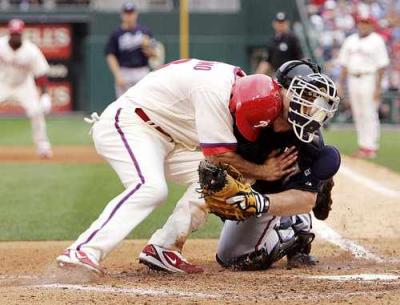Breadcrumb
Concussion Training & Education

Facts AND Statistics
- 1.6 to 3.8 MILLION concussions occur each year. [7]
- 34% of concussions occur in Practice and 65% occur in Competition. [2]
- Effects of concussions are cumulative in athletes who return to play before complete recovery. [4,6]
- The younger the athlete the longer the recovery time. [3]
- Second impact syndrome is rare. But PREVENTABLE.[1]
- Terms such as ”Bell ringers”, “Dings” or grading of concussions are no longer used.

What is a Concussion?
A concussion occurs when an athlete receives a traumatic force to the head or upper body that causes the brain to shake inside of the skull. This may cause a change in mental status such as loss of consciousness, amnesia, disorientation, confusion or mental fogginess.
Signs and Symptoms of a Concussion
SIGNS | SYMPTOMS |
|---|---|
|
|
What to do if there is a suspected concussion?
Take the conservative approach...WHEN IN DOUBT, SIT THEM OUT. If a concussion is suspected, the student may not be allowed to continue with the current activity until properly evaluated and cleared by physician or medical professional.
When can a player play again?
All players must follow a 'Return to Play' Protocol upon the clearance of a physician. Return to Play protocol is a gradual step wise approach.
Guidelines for the Return to Play Protocol-
- Any athlete who exhibits signs or symptoms of a concussion should be removed from the activity right away.
- WHEN IN DOUBT, SIT THEM OUT
- All criteria must be meet before beginning a return to play protocol:
- Asymptomatic at rest (mental & physical)
- Within normal range of baseline on post-concussion Impact & Balance testing done by North Coast Concussion Program (NCCP)
- Have a written clearance from team physician, designee, primary care physician or specialist.
- Return to Play Protocol: Once the criteria is met, the athlete will progress back to activity following a stepwise progression. Progression is individualized. Each step is 24 hours without symptoms. IF SYMPTOMS RETURN, athlete must return to a STEP BELOW (or previous) and rest 24 hours before resuming.
TRAINING/EDUCATION FOR COACHES AND CLUB OFFICERS
- Online Training: NFHS Learning Center
- Sideline Evaluation: Use this checklist to check for common symptoms
- Return to Play Protocol: NFHS Process and management
Cal Poly Humboldt Resources
Concussion Baseline Testing
Contact Beth Larson to set up appointments to get your team tested
- Main Line (707) 826-4540
- Work Cell (707) 273-3035
- Email: nccp@humboldt.edu
- Health Center: Physician Care
- Phone: (707) 826-3146
- North Coast Concussion Program (NCCP): Concussion ImPACT & Balance testing
- Phone: (707) 826-4540, Email: nccp@humboldt.edu
- Student Disability Center: Academic Accommodations
- Phone: (707) 826-4678, Email: sdrc@humboldt.edu
Resources related to concussion management, practice, diagnosis et.al can be found at the following sites:
- CDC (IMPACT Program): http://impacttest.com/concussion/overview
- NCAA: http://www.ncaa.org/health-and-safety/medical-conditions/concussion





